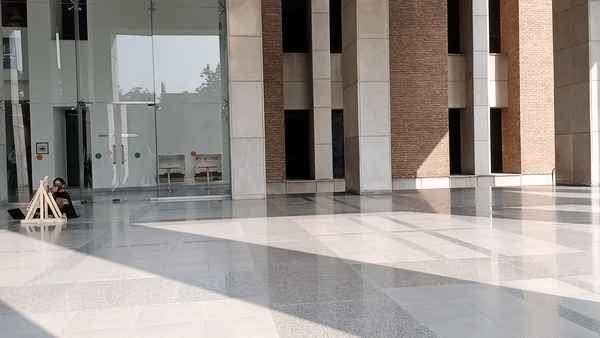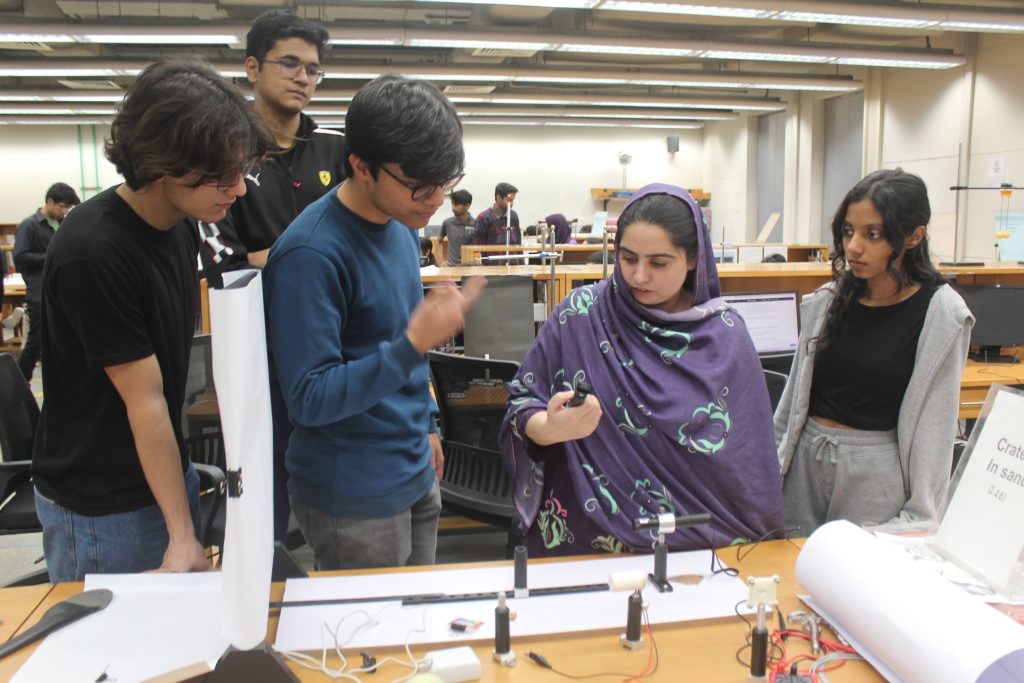
“Students should be made to think, to doubt, to communicate, to question, to learn from their mistakes, and most importantly have fun in their learning”. – Richard Feynman
From mere freshmen to aspiring builders, this year, PhysLAB at the Syed Babar Ali School of Science and Engineering (SBASSE) experienced a paradigm shift in the approach to teaching science and engineering within its instructional laboratories.
In the Fall 2023 semester, students found themselves unable to locate the conventional Experimental Physics (PHY-100) course in their Zambeel portal. Instead, they were prompted to enroll in a new “Design & Measurement (ENGG-100) Lab.” Puzzled and confused, the students sought guidance from their seniors, who were equally surprised by this unexpected change. However, this transformation wasn’t impromptu; it was the result of months of contemplation within the school’s faculty on how to make the introduction to science and engineering for freshmen more interactive and practical. The primary question at hand was how to propel these students beyond their comfort zone of being mere observers and performers to becoming the builders and inventors of tomorrow. The culmination of this deliberation unfolded when the ENGG-100 course finally commenced. This course was uniformly offered across three departments: the Department of Electrical Engineering, Chemical Engineering, and the Department of Physics. Following initial coherent instruction, students engaged in four weeks of curated projects tailored to various themes based on the specific requirements of their respective departments. In Physlab’s offering, students navigated the path as outlined below.
It all began with the customary introduction to the laboratory’s most critical aspect—uncertainties, skillfully led by the esteemed faculty member, Dr. Ammar Ahmad Khan. The intricate world of MATLAB for data processing was thoroughly explored under the guidance of our Senior Lab Instructor, Azeem Iqbal, while the laboratory sessions were expertly moderated by Kaneez Amna and Tayyaba Umer. The engaging sessions were made possible through the invaluable contributions of our Lab Facilitator, Ali Hassan. His unwavering support in maintaining the laboratory, including the upkeep of computing systems, printers, and overall management, formed the foundation for all sessions to take place.
After mastering these fundamentals, students delved into the realms of 3D modeling and printing, skillfully covered by our new Lab Instructor, Faisal Saeed. This meticulously crafted module spanned six hours each over two days.
On the initial day, students immersed themselves in Fusion 360, mastering the art of transforming their ideas into three-dimensional models. The subsequent day was dedicated to exploring the process of importing these models into slicing software, such as “Cura”, and then materializing them using the budget-friendly 3D printer known as ‘Markhor3D.’ This module served as a refreshing departure, empowering students to rise above the intricacies of measurements and data analysis. Umer Hassan, the founder of Markhor3D, captivatingly covered this module. The students, distinguished by their keen intellect and enthusiasm, promptly set out to construct designs and models, displaying remarkable energy and interest. This comprised a five-week pre-laboratory training, imperative for any freshman before plunging into laboratory experiments.


After these initial weeks, students were immediately immersed in the realm of experimental physics. Amidst their tasks, they grappled with phenomena, engaged in complex mathematical modeling, experienced exhilarating experimental efforts, undertook tiring data analyses, and meticulously curated it all into their laboratory notebooks, culminating in a viva with their instructors. This journey possesses a life of its own, exposing students to all domains of physics and challenging them to transform into rigorous scientists on a mission, akin to warriors investigating hidden phenomena in a laboratory.
However, as mentioned earlier, this wasn’t the entirety of it. These ten weeks of our conventional coursework, enriched with additional modules, were followed by something that unfolded as a mini science festival — a ‘mela’.”
The final five weeks of the ENGG-100 course at Physlab were entirely dedicated to building and inventing. Students were grouped, and four project ideas were presented. Through a random draw, students were allocated to the four lab instructors in the laboratory, with each instructor assigned to a specific project. The projects were:
- Investigating coupled oscillators (Kaneez Amna)
- Exploring electromagnetic induction (Faisal Saeed)
- Optical activities of different solvents (Tayyaba Umer)
- Building a medieval Trebuchet (Azeem Iqbal)
To facilitate this, the instructors collaboratively devised a classical and industrious scheme for the product development life cycle. This scheme, however, was tailored to unfold within a condensed timeline of four weeks. The objective was to immerse students in experiential learning, embracing the principles of the Do-It-Yourself (DIY) movement. The students navigated through the phases in the following fashion:
- Week 1 (Research/Plan/Design)
- Week 2 (Prototype/Build/Assembly)
- Week 3 (Data acquisition/Analysis)
- Week 4 (Results/Compile/Report/Present)
From the very first week, we witnessed a monumental shift in our decade-long experimental adventures. The students shed the weight of experimental challenges and seamlessly transformed into teams of scientists, engaging in exhilarating debates, arguments, and contemplations on the possibilities of transforming their ideas into tangible products. The lab instructors played the role of project facilitators, serving as both coaches and mentors, guiding their vibrant thoughts towards the ultimate goal.
Students were tasked with preparing a comprehensive report of at least two pages, a schematic of their proposed design, and a Bill of Materials (BOM) essential for building their product in the upcoming week.

Starting from the second week, every individual in the lab rolled up their sleeves, donned safety gear, powered up machinery and tools at their stations, and immediately delved into the manufacturing of their setups. Randomly, one could hear the loud screeching sound of the wood cutter for teams working on Trebuchets, juxtaposed with the rigorous noise of an investigator cutting a PVC pipe using a hand saw and a blade. In various corners, students were seen cutting wires and crafting circuits, often encountering failure after failure. The workshop team, led by Khadim Mahmood and Imran Jan under the supervision of Hafiz Muhammad Rizwan, played a pivotal role in providing crucial support for the manufacturing of all project hardware. Meanwhile, audible sighs expressed moments of frustration and contemplation of giving up, met with instructors joining to impart wisdom about the realities of life. Indeed, this week served as the foundational step, laying the first brick for a better tomorrow.
The third week kicked off with an overwhelming sense of enthusiasm and optimism that is challenging to express in words. The students were motivated, knowing they had already traversed the challenging path of building their prototypes. Now, the task at hand was to make things actually work. Collaborating as teams of scientists and engineers, students divided roles and responsibilities, initiating the assembly of their products. While some had already begun this process in the preceding week, we granted flexibility based on project management principles.
To our amazement, within just one hour, the majority of projects were in full shape and had started functioning! The students experienced a sense of bliss similar to an entrepreneur witnessing their Minimum Viable Product (MVP) generating its first revenue. According to the plan, students promptly began recording data on how their products were performing. Although the results were at times completely off or even entirely wrong, we consistently emphasized the importance of realizing the journey of a scientist and engineer. No one gets it right the first time. It’s always the experiential journey and the brave reconsideration of one’s mistakes that propels one towards the true answers. So, the first set of data was generated and meticulously logged in student notebooks, as well as in the day’s two-page reports.

The last week marked the pinnacle of this endeavor. Having hustled through three weeks of transforming an idea into a prototype with some initial performance, the students were now in high spirits to make their creations fully operational. This is when Umer Hassan, our laboratory’s catalyst, was introduced into the chemical reaction of creative minds. Umer, with his meticulous expertise in electro-mechanical engineering, immediately ignited the students’ ability to fine-tune their projects into finished products.
The results were astonishing! Trebuchets launched counterweights to distances of 6 to 10 meters. Air tracks smoothly glided couple oscillators, wounded PVC and copper pipes defied gravity, and the mix of optically active solutions bent monochromatic lights from lasers. The students embraced this vigor jubilantly, with some even taking the trebuchets outside the SSE building, almost in the mood to bring down the M7 hostel building.

The students then gathered all their experiences, data, pictures, graphs, and results, transforming it all into a captivating final report that served as the conclusive documentation of their journey through the Measurement & Design (ENGG-100) course.
| Project Title | Students | Instructor |
| Modelling projectile motion using a Trebuchet | Ayaan Ahmed, Syed Yshel Ali, Zainab Usman, Mehreen Iqbal | Azeem Iqbal |
| Electromagnetic Induction and Associated Phenomena | Abdullah Tahir, Areej Fatima, Ayma Aamir, Hamid Ali Khan | Faisal Saeed |
| Investigating coupled oscillators using a linear air track | Abdul Nafae Imran, Abdul Moeez Khurshid, Muneeb ul Haq, Zaryab Gohar | Kaneez Amna |
| Measuring wavelength of light & optical activity of chiral solutions | Muhammad Mohib Haider, Abeer Zahid Bhatti, Muhammad Ammar Faisal, Syed Muhammad Murtaza Hassan | Tayyaba Umer |
Pakistan, with a population of 220 million, faces a significant hurdle in its journey toward achieving global recognition as investors and technology builders. The primary obstacle lies in the mindset, and in this mission, the most substantial responsibility rests on the shoulders of our educators. Whether you are a well-supported teacher in the esteemed halls of an institute like LUMS or a struggling educator in the remote areas of inner Sindh, the responsibility is equal—to open up the hearts and minds of students.
The core duty is to transform them into compassionate human beings, ready to listen, recognize, and appreciate one another. Additionally, it is essential to equip them with the power of knowledge, enabling them to break the shackles of mental slavery and truly become the inventors and builders, the budding scientists and engineers of Pakistan. The transformative impact of educators, regardless of their setting, holds the key to unlocking the potential that will propel Pakistan forward on the global stage.













